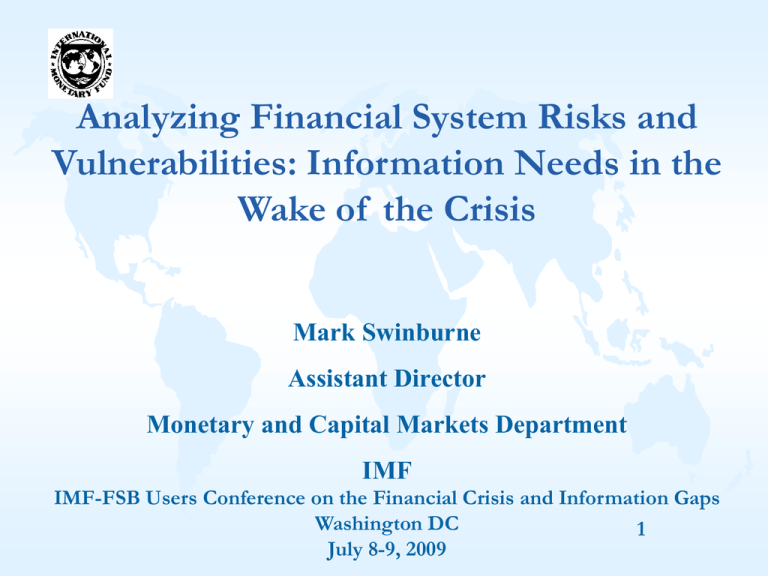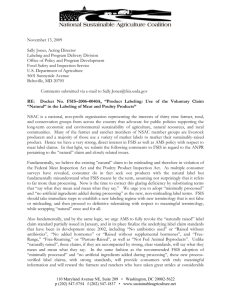Analyzing Financial System Risks and Vulnerabilities: Information Needs in the Mark Swinburne
advertisement

Analyzing Financial System Risks and Vulnerabilities: Information Needs in the Wake of the Crisis Mark Swinburne Assistant Director Monetary and Capital Markets Department IMF IMF-FSB Users Conference on the Financial Crisis and Information Gaps Washington DC 1 July 8-9, 2009 Outline I. First Principles: What Does System Stability Analysis Need to Cover? II. How do FSIs Fit In? III. Lessons from the Crisis for System Stability Analysis 2 What Does System Stability Analysis Need to Cover? (1) Financial system stability analysis is still a young “industry”. (Goodhart’s comparison with IT frameworks in the monetary policy area.) Theoretical and empirical work continues to push out the boundaries of stability modeling (and the crisis will doubtless be fodder for this for years to come!) But there is still no one generally accepted conceptual model, approach or data set that can tell us all we need to know. So need to take a fairly pragmatic, eclectic approach draw on a range of analytical approaches and indicators, without undue reliance on any one set. Use as cross-checks, complementary perspectives 3 What Does System Stability Analysis Need to Cover? (2) Assessment of macroeconomic and external financial developments with a potential bearing on the soundness of the domestic financial system Assessment of the strength and vulnerabilities of financial institutions; markets; infrastructure; AND the policy framework. Assessment of transmission channels / propagation mechanisms linkages within and between parts of the financial system ( a systemlevel perspective) linkages back to the real economy (feedback loops) Linkages across borders (especially for the IMF, in both directions) Policy implications 4 What Does System Stability Analysis Need to Cover? (3) Stability analysis needs to be holistic and “imaginative”, in order to help better “connect the dots”. But the factors listed above are a potentially large “shopping list” of issues to cover. Need to prioritize—more of a “menu” than a “shopping list”. Focused analysis, and more effective messages. Scarce resources Risk of “missing something” is always there. Underlying process to draw on a wide set of inputs and views before filtering down Retain flexibility to continue to learn as we go 5 What Does System Stability Analysis Need to Cover? (4) To bring together the various aspects of a stability assessment, and help prioritize, one useful approach is a framework explicitly distinguishing between likelihood of identified risks eventuating, and their potential impact should they eventuate. Identify risks – assess likelihood – assess impact – policy measures An iterative process, continually reviewed and revised Can help identify gaps in the analysis and evidence Can help guide where further “drilling down” is needed. Bottom line still heavily judgmental, but quantitative analyses wherever feasible can inform the judgments and sharpen messages 6 What Does System Stability Analysis Need to Cover? (5) A range of analytical tools needs to be deployed, including: • Review of FSIs and other balance sheet, income, and expenditure aggregates; sectoral and peer groups levels. • Analysis of market indicators • Stress testing and scenario analysis • Assessment of resilience of key financial markets, and the supporting systemic liquidity arrangements (central bank facilities and operations) • Assessment of regulatory and supervisory frameworks, and key infrastructures (e.g., payment and securities settlement systems) can be formalized and standardized through use of International Standards and Codes; or can be less formalized / more targeted analyses. • Qualitative assessment of financial system safety nets (e.g., deposit insurance, LOLR facilities), and crisis management arrangements (e.g., bank resolution framework) 7 How do FSI’s Fit In? (1) • Over the last decade, a large effort in inter-institutional and international consultation and cooperation, • focusing especially on getting understood and agreed methodologies and improving international data comparability. An emphasis on metadata. • Major initial obstacles to overcome. Landmarks have been: • Production of the FSI Compilation Guide • Completion of the Coordinated Compilation Exercise (CCE) • Review of experience in the CCE, and selected revisions to compilation • FSIs now widely available in country FSRs, FSSAs, and AIVs, though often not yet very comparable cross-country or in accordance to the Guide. • But regular reporting consistent with the agreed methodologies is now 8 underway and gaining steam. How do FSI’s Fit In? (2) • Most FSIs aggregate bank-level supervisory data • Needed to help assess risks to the financial system as a whole. • Necessary but not sufficient • FSIs complement supervisory indicators for a bank • The later help assess risks at the individual bank level (e.g. CAMELS) • Aggregation reveals (some) risks missed at micro level— especially of the common exposures variety • FSIs are a subset of a much broader group of macroprudential indicators (e.g., debt/GDP, international reserves) that need to come into the stability analysis. 9 What FSIs can and cannot tell you • FSIs mostly reveal current condition of financial sector • Help show vulnerabilities and capacity to absorb losses (i.e. impact of potential risks) • Some nonbank FSIs (e.g., corporate leverage, housing prices) contain potentially leading information on bank balance sheet developments. (Though currently these are often not readily available.) • Stress testing gives FSIs forward-looking perspective • They cannot tell you much about the probability of shocks or a crisis • So use FSIs with crisis prediction indicators (e.g. FM data) • They cannot tell you about concentrations of vulnerabilities that may be disguised by aggregation • They may not tell you much about interlinkages and contagion channels • They cannot, by construction, tell you about what is going on outside the aggregation 10 What FSIs can and cannot tell you (2) • Focus on identifying vulnerabilities • Some information on (some) propagation mechanisms Stages of a financial crisis (“Manias, Panics and Crashes” by Kindleberger) Focus of surveillance using FSIs 1. Shock (risk monitored with market indicators) 2. Vulnerabilities → capital & liquidity problems 3. Propagation mechanism: financial weaknesses → systemic liquidity problems & credit crunch 4. Feedback mechanism: from financial sector to the real economy, which could portend more problems for the financial sector from a deeper macro downturn (2nd round effects on the FS balance sheets) 5. crisis 11 FSIs must be used with other indicators Financial market surveillance Financial shocks Business cycle shocks External shocks Macroprudential surveillance Bank sector vulnerabilities Capital adequacy Analysis of macrofinancial linkages Financing role of banks Monetary transmission Debt sustainability Macro surveillance Macroeconomic conditions Types of Indicators/data Financial market data, early warning indicators, macro forecasts & data FSIs (e.g. • Corporate leverage • Liquidity and FX risk • NPLs/loans • Capital ratio) Supervisory and financial infrastructure information Interest rates and spreads Credit growth Monetary data & policy Sectoral balance sheets REER, wages, EMBI 12 spreads, macro policies Lessons from the Crisis for System Stability Analysis (1) The crisis has highlighted a number of key areas where systemic stability analysis, and the quantitative models and data used for it, need to be further strengthened. First, broad financial system trends, and the incentives under which financial markets operate, can be critical for stability of financial systems. Careful monitoring and assessment needed. Second, continued upgrading of analytical methods is a major priority. Richer, more rigorous modeling of risks and their impact is needed. Third, better information and data in some key areas is needed. Information gaps hampered assessment and appreciation of systemic and cross border risks and vulnerabilities, pre-crisis. E.g. the “shadow banking” sector. 13 Lessons from the Crisis (2) Major structural trends in financial markets & interrelationships with broad economic incentives were underappreciated overall. Savings/investment balances globally, plus strong demand for credit in many countries; relatively benign inflation and monetary policy outlooks Continued financial and technical innovation that reduced costs of globalization as well as regulatory arbitrage Growing importance of markets and of institutional investors, other NBFIs, relative to more traditional banking Growing importance of complex structured products, risk transfer instruments, off-balance sheet activities and entities, trading in OTC markets; and growing importance of a similar group of major players across a range of key financial market Global or at least international financial developments increasingly important for financial stability in a growing range of countries (LICs as well as EMs). Foreign banks, direct cross border banking transactions, foreign investors in securities markets. For the future: Identify and monitor such trends; assess potential implications for risks and vulnerabilities in national financial systems; convey policy significance convincingly. Global financial stability issues increasingly important for national analysis. 14 Lessons from the Crisis (3) At the technical level, system stability analysis needs to be strengthened through more rigorous assessment of system-level tail risks. In terms of quantitative analysis like macro stress testing, this is only partly an issue of size of the trigger event. Probably even more important is making the modeling process richer: Capturing the whole distribution of losses in any scenario, so as to reflect unexpected losses not just the expected losses Richer definitions of scenarios and their effects—e.g., combinations of credit risk with counterparty, liquidity and market risk, not just the credit risk aspect alone More generally, improving the methodology for liquidity stress testing Richer modeling of contagion and spillover effects, both within the financial sector per se and the macroeconomic-financial feedback loop; including cross border aspects where feasible. And allowing for some non-linearities—e.g., time-varying default dependencies Progress is being made in a number of these areas. The work gets complex very quickly, and it is too early to describe it as “stress testing, generation II”. But the direction of movement seems right. 15 Lessons from the Crisis (4) As others have noted, there have been important information gaps relating to the very financial activities that have been expanding most rapidly. Areas such as: Risk exposures of major banks to complex structured products and offbalance sheet entities Their cross-border exposures and related capital flows. Their asset valuation techniques and risk models Lack of transparency in OTC traded instruments Limited information on potentially systemic NBFIs A number of initiatives are already underway to address many of these, and previous speakers have offered a number of further proposals. 16 Lessons from the Crisis (5) For the FSIs specifically, some further adjustments clearly desirable. In the original spirit of the program Some reprioritization, eg leverage; corporate, real estate, and household indicators Some extensions eg perimeter of consolidation, key NBFI indicators, further liquidity and market indicators. More disaggregation / dispersion measures in future. Many other aspects of improving financial sector reporting and disclosure will be outside the formal FSI work program. Complementary. For users, adjustments along above lines will ease some of the current limitations. But need will remain to: Keep FSIs in perspective—only a subset of the desirable information and data Interpret them carefully As has been the case from the start 17


